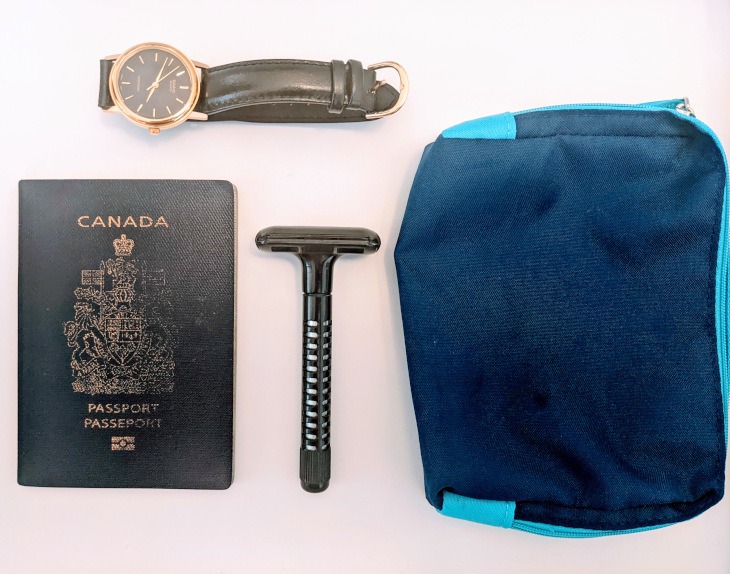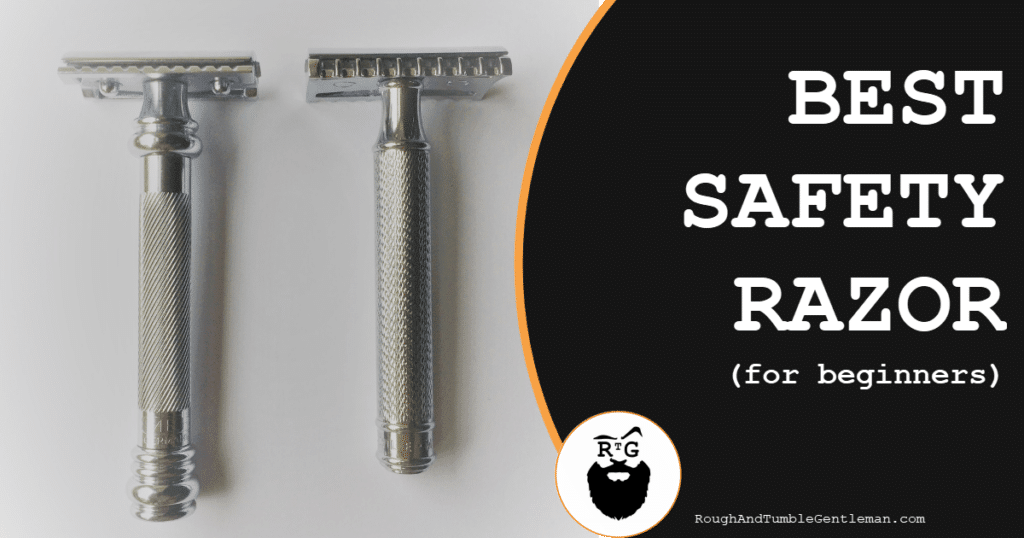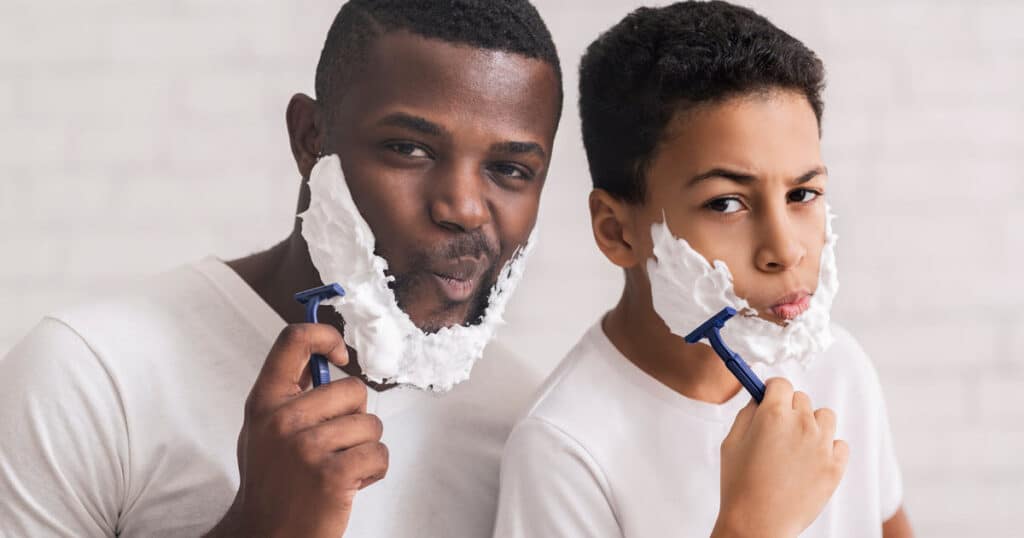Cleanliness is next to godliness (or at least so we’re told). Having a clean double-edge (DE) safety razor will help keep your prized tool in great shape for the years to come. But it’s not uncommon to wonder how to clean a safety razor correctly.
Fear not, because we’ve put together a complete guide to help you out. We explain the cleaning process step-by-step, along with some advice based specifically on the kind of grime you may encounter. Just as important is keeping your razor dry, using the right products, and avoiding common pitfalls.
If you’re new to wet shaving and using a beginner safety razor, or if you’re an old pro and you’re using an aggressive model, there’s something here to help you keep your gear clean and functional.

Let’s get to it:
Cleaning Your DE Razor Step-by-Step
We’ll start at the beginning:
Step 1: Give It a Rinse
Once you finish shaving, never skip rinsing your razor. You can slightly loosen your double-edge razor if you like, and then place it under the running tap. Run the water as hot as it’ll go—just be careful not to burn yourself—and rinse the head of your razor until all hair and soap remnants are gone.
Step 2: Disassemble It
With your razor mostly free of shaving residue, you should now disassemble it for a deep clean. Different kinds of safety razors come apart differently, so be careful when taking yours apart. Remove the razor blade from the razor, and put it away to recycle.
Step 3: Examine the Parts
With your safety razor in pieces, look it over closely to see what kind of condition it is in, and which areas are the dirtiest. Do you spot any mineral buildup? How about rust? Keep that in mind when deciding which of the following steps you should take.
Step 4: Rub It Down
For a speedy, all-over clean, you can give your DE razor a quick rubdown with warm water and dish soap. You can use your hands, a cleaning cloth, or a non-abrasive sponge.
Step 5: Get into the Crevices
For the harder-to-reach spots on your safety razor, a toothbrush will come in handy. Dip the toothbrush in a bit of soap, and then use it to concentrate on areas that the simple all-over rubdown didn’t clean.
Getting into the crevices is especially important for butterfly safeties, which tend to have a lot of odd corners that collect gunk—so if you’re using a butterfly safety, pay special attention to this step.
Step 6: Soak If Necessary
If your razor has a lot of mineral buildup or rusty spots that won’t come off with simple cleaning or brushing, you may want to give your razor a soak. Place it in a bowl filled with 1 part white vinegar and four parts water for around 5-10 minutes. Then, use a toothbrush to brush it down again. Don’t do this too frequently, as it may damage the metal.
Step 7: Give It a Final Rinse
No matter how you cleaned your razor, in the end, it’s important to rinse away all of the vinegar or soap residue with the help of hot water.
How to Dry Your Safety Razor
OK, so we’ve talked about how to clean a safety razor. The next step? Drying it out.
Dryness is a big element of cleanliness. Water and moisture breed bacteria and lead to rust, so when you dry your safety razor correctly, you can keep it clean and durable for the long term.
So, once you’re done cleaning your razor, don’t compromise on drying and storing it.
First, shake off the excess water into the sink. Then, use a clean towel to gently dry the individual components of your safety razor. You can place the pieces of your safety razor on a towel, and then fold it over top and press gently to get rid of excess moisture.
Once your razor is mostly dry, you can put it back together. Finally, store it upright in a cup or—even better—in a dedicated razor holder (we like the Perfecto Deluxe Chrome Razor and Brush Stand), away from your shower or sink where it can get moist again.

Products to Use When Cleaning Your Safety
You probably already have all of the razor cleaning supplies you’ll need in your home. If you don’t, no worries—here are some of our favorite safety razor cleaning products.
Product 1: Dish Soap
Dish soap is a simple, classic choice for cleaning razor blades from soap scum and other grime. Unlike regular soap or shampoo, it doesn’t include any added moisturizers that could leave a residue on your razor.
The dishwashing soap you choose doesn’t matter too much, but if you don’t have any on hand, we like Mrs. Meyer’s because it comes in a large container, is biodegradable, and has a pleasant basil scent.
Product 2: Scrubbing Bubbles
Scrubbing Bubbles is a bathroom cleaner designed specifically to remove soap scum. Many wet shavers have adopted it as their go-to razor cleaner, instead of dish soap. We find that this formula is very effective against the more stubborn deposits, although it can be a little harsher on the hands so you may want to use gloves when handling it.
Product 3: Barbicide
Barbicide Salon Disinfectant is a popular disinfectant made for barbers, hairdressers, and estheticians to use in the salon. To use it, you’ll need to first dilute it in water, as written on the packaging.
It helps to kill all of the pathogens that can make their home on tools like scissors, tweezers, and, of course, razor blades. It’s formulated with metallic tools in mind, so we also find that it can help prevent rusting.
Product 4: Vinegar
If you’re dealing with rust or mineral build-up, simple white vinegar is quite effective. Its acidity reacts with the rust and dissolves it, leaving you with a nicer-looking, safer razor.
However, if you have a chrome safety razor, you may want to avoid the vinegar altogether. It can strip away the chrome and cause damage, especially if you leave your razor to soak in it.
Product 5: Alcohol
Alcohol is an accessible alternative to Barbicide for when you want to disinfect your razor. Unlike Barbicide, it doesn’t have the added ingredients to protect the metal, but it still works well to kill pathogens with a good 10-minute soak.
Product 6: Deep Clean Brush Set
An old, soft toothbrush is a perfectly fine tool for cleaning your DE razor, but we feel that the OXO Good Grips Deep Clean Brush Set is a nice upgrade. The larger brush can work well for cleaning the top and handle of your razor, while the smaller one can fit more easily into curves and under edges. Finally, the wiper blade on the smaller brush offers even more precision cleaning.
Problem Solving Razor Cleaning Issues
If you run into some really stubborn spots on your razor, here is how you can deal with them!
Problem 1: Rust
Most of today’s safety razors are made out of non-rusting metals. Even so, rust from your blade can still build up on your razor, and removing it is essential. The best way to remove rust is with a short vinegar soak followed by a scrub with a soft toothbrush.
If the rust buildup is particularly stubborn, you can also (very gently!) scrub away at it with a metal scourer, but be very careful not to abrade your actual razor.
Problem 2: Hard Water Buildup
Removing hard water buildup from your safety razor is very similar to removing rust. Hard water buildup, after all, is simply a collection of minerals. Once again, a short vinegar soak followed by a scrub will work best.
Problem 3: Disinfection
If you’ve picked up a second-hand razor, or you’d like to give a razor you’ve already used as a gift, it’s very important that you don’t just clean it, but disinfect it. It’s also important to do if you’ve accidentally cut yourself while shaving or if you had some sort of skin infection, including folliculitis.
To disinfect, simply let the razor soak for around 10 minutes in a metal-friendly disinfectant like alcohol or Barbicide. Then, rinse and dry it thoroughly, and it’ll be ready to use again.
Make sure to avoid bleach-based disinfectants, since highly-alkaline materials are more likely to damage the metal even with very short contact.
Why Cleaning Your Razor Matters
You use it with soap and water, you’re constantly rinsing it…. So why should you clean your double-edge safety razor, anyway? While for some this might seem self-explanatory, here are the two main reasons why the cleanliness of your razor matters.
It prevents infections. While the part that’s most likely to come in contact with broken skin is your razor blade, keeping your razor disinfected is still important. A dirty razor can lead to all kinds of issues from folliculitis and acne to potentially even tetanus.
It helps your razor last. A clean razor is a more durable razor! Rust and mineral build-up, in particular, will weaken the metal and shorten the lifespan of your razor.
It gives you a better shave. A good shave is all about the glide, and a razor head that’s covered in soap scum isn’t going to move as smoothly over your skin.
It keeps your counter looking good. A clean razor just looks nicer, and isn’t that half the fun of wet-shaving? It has a nice sheen, and it gleams elegantly on your counter in a way that a dull, grime-covered razor simply does not.
How Often Should You Clean Your Razor?
How often you clean your DE safety razor depends on how often you shave, the type of shaving aids you use, as well as on the quality of the water where you live.
In general, you should always rinse your razor thoroughly with hot water after every shave. Doing this might actually help you avoid the need for frequent deep cleaning, since hot water can remove a lot of gunk.
Doing a full deep clean as we outlined above, however, really depends on your circumstances, so you should pay close attention to your razor to decide. The best time to clean your razor is when you notice that it’s starting to look grimy.
If you live in an area with hard water or your go-to shaving soap is very rich, you’ll probably notice a buildup of minerals or soap scum collect on your razor pretty quickly. In that case, you’ll need to thoroughly clean your double-edge safety razor more often—around once a week or so.
On the other hand, if the water in your area is quite soft and your shaving cream or soap rinses away completely and easily, you’re in luck! Chances are you can get away with only cleaning your razor once a month or so, and you’ll likely be able to skip the intense steps like soaking and rubbing with a toothbrush.
A Clean Razor for a Clean Shave
Wet shaving is more than a grooming habit. It’s a hobby and a point-of-pride, using tools meant to last for years. Learning how to clean a safety razor is another way of enjoying your hobby, not to mention that it’s so important for the greatness of your shave.
We hope there’s something here that helps you keep your gear clean. In the meantime—have fun, be good, and happy shaving (and cleaning!).
Michael Morris is the head writer here at Rough and Tumble Gentleman. He's got a ducktail beard and loves Brazilian jiu-jitsu. He's married to the woman of his dreams and lives in Brooklyn, NY.




